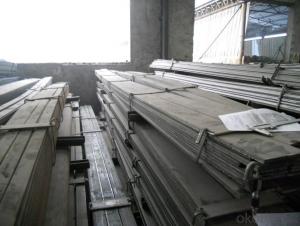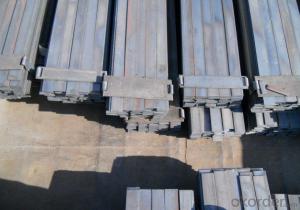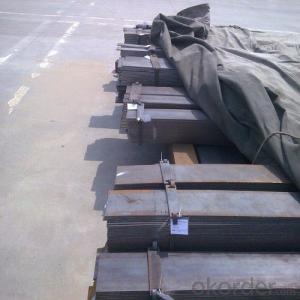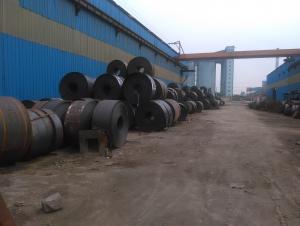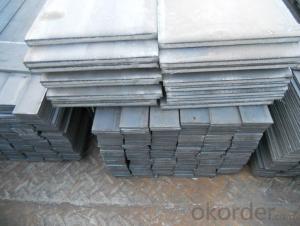Hot rolled flat bar; flat steel
- Loading Port:
- Tianjin
- Payment Terms:
- TT OR LC
- Min Order Qty:
- 50 m.t.
- Supply Capability:
- 10000 m.t./month
OKorder Service Pledge
OKorder Financial Service
You Might Also Like
Specifications of MS Channel:
1.We supply high quality MS Channel at reasonable price, including Chinese standard, Japanese standard and so on.
Standard | GB/JIS |
Material Grade | Q235,SS400 |
Technique: | Hot Rolled |
Sizes as per chinese standard: | 50*37*4.5mm - 300*89*11.5mm |
Sizes as per japanese standard: | 50*25*3mm – 200*80*7.5mm |
Length: | 6meter, 9meter, 12meter |
Note: 1.we are also competent to provide our customers other MS Channel based on other sizes according to customer’s requirements.
2. The length of our ms channel could be cut into other meters as per customer’s requirements. For example, the channel in 6meters could be cut into 5.8meters in order to be fit in the 20ft container.
2. The detailed sections of MS Channel as per GB standard.are shown in the table-1:
GB U CHANNEL | Standard | Sectional | Dimension |
| Mass: |
(mm) | (mm) | (mm) | (mm) | ||
50X37 | 50 | 37 | 4.50 | 7.0 | 5.438 |
63X40 | 63 | 40 | 4.80 | 7.5 | 6.634 |
80x43 | 80 | 43 | 5.00 | 8.0 | 8.045 |
100x48 | 100 | 48 | 5.30 | 8.5 | 10.007 |
120x53 | 120 | 53 | 5.50 | 9.0 | 12.059 |
140x58 | 140 | 58 | 6.00 | 9.5 | 14.535 |
140x60 | 140 | 60 | 8.00 | 9.5 | 16.733 |
160x63 | 160 | 63 | 6.50 | 10.0 | 17.240 |
160x65 | 160 | 65 | 8.50 | 10.0 | 19.752 |
180x68 | 180 | 68 | 7.00 | 10.5 | 20.174 |
180x70 | 180 | 70 | 9.00 | 10.5 | 23.000 |
200x73 | 200 | 73 | 7.00 | 11.0 | 22.637 |
200x75 | 200 | 75 | 9.00 | 11.0 | 25.777 |
220x77 | 220 | 77 | 7.00 | 11.5 | 24.999 |
220x79 | 220 | 79 | 9.00 | 11.5 | 28.453 |
250x78 | 250 | 78 | 7.00 | 12.0 | 27.410 |
250x80 | 250 | 80 | 9.00 | 12.0 | 31.335 |
250x82 | 250 | 82 | 11.00 | 12.0 | 35.260 |
280x82 | 280 | 82 | 7.50 | 12.5 | 31.427 |
280x84 | 280 | 84 | 9.50 | 12.5 | 35.823 |
280x86 | 280 | 86 | 11.50 | 12.5 | 40.219 |
300x85 | 300 | 85 | 7.50 | 13.5 | 34.463 |
300x87 | 300 | 87 | 9.50 | 13.5 | 39.173 |
300x89 | 300 | 89 | 11.50 | 13.5 | 43.883 |
Table-1
3. The chemical composition of HR Channel Steel according to Q235B is shown in Table-2.
Alloy No | Grade | Element(%) | ||||
C | Mn | S | P | Si | ||
Q235 | B | 0.12-0.20 | 0.3-0.7 | ≦0.045 | ≦0.045 | ≦0.3 |
Table-2
Note: we are able to present our customers relevant SGS test report for chemical composition of HR Channel Steel.
4. The mechanical property of HR Channel Steel according to Q235B is shown in Table-3-1 and Table-3-2
Alloy No | Grade | Yielding Strength Point(Mpa) | |||
Thickness(mm) | |||||
≦16 | >16-40 | >40-60 | >60-100 | ||
≧ | |||||
Q235 | B | 235 | 225 | 215 | 205 |
Table-3-1
Alloy No | Grade | Tensile Strength(Mpa) | Elongation After Fracture(%) | |||
Thickness(mm) | ||||||
≦16 | >16-40 | >40-60 | >60-100 | |||
≧ | ||||||
G235 | B | 375-500 | 26 | 25 | 24 | 23 |
Table-3-2
Note: we are able to present our customers relevant SGS test report for mechanical property of MS Channel as customer’s request.
Applications of MS Channel:
The MS Channel can be applied to construction of warehouses, workshops, sport stadiums and car parks etc.The hot rolled channel steel belongs to carbon structural steel which is applied to in the field of construction and machinery.In details, the hot rolled channel steel is usually used for arch-itechtural structure, and they could be welded in order to support or hang a vari-ety of facilities. They are also usually used in combination with I beam. Generally,the hot rolled channel steel we supply must possess perfect welding property, riveting property and mechanical property and so on.
Package & Delivery of MS Channel:
1.The hot rolled channel steel will be packed in bundle with steel wire at each end of every bundle and color marking in order to help the customer to recognize his goods more easily at sight.
2. And the hot rolled channel steel could be loaded into 20ft or 40ft container, or by bulk cargo.If the weight of each bundle reaches more than 3.5 mt, the loading by break bulk cargo should be choosed.When the weight of each bundle reaches less than 3mt, the loading by container should be choosed.
3.As for the transportaion from mill to loading port, the truck will be usually used. And the maximum quantity for each truck is 40mt.
4.All in all, we could do in accordance with customer's request
- Q:Can steel flat bars be easily painted or coated?
- Steel flat bars can be painted or coated with ease. The sleek and even surface of steel flat bars allows for a simple application of paint or coatings. Before painting or coating, it is crucial to ensure that the surface is clean and devoid of any rust, dirt, or grease. This can be achieved by sanding the surface and using a suitable cleaner or solvent. Once the surface is properly prepared, a primer can be applied to enhance the adhesion and durability of the paint or coating. Finally, the desired paint or coating can be applied using a brush, roller, or spray method. It is advisable to follow the manufacturer's instructions for the specific paint or coating being used. In general, steel flat bars offer a suitable surface for painting or coating and can be easily transformed to meet various aesthetic or protective requirements.
- Q:Can steel flat bars be used for marine applications?
- Indeed, marine applications can make use of steel flat bars. Nevertheless, the choice of steel is of utmost importance in assessing its compatibility with marine surroundings. Specifically, stainless steel flat bars exhibit exceptional resistance to corrosion and, hence, are commonly employed in marine applications owing to their remarkable strength and durability. The capacity of stainless steel to resist rust and corrosion renders it suitable for deployment in saltwater environments, where conventional carbon steel would rapidly degrade. Consequently, when making a selection of steel flat bars for marine applications, it becomes crucial to opt for stainless steel in order to guarantee longevity and optimal performance in the face of challenging marine conditions.
- Q:Is medium plate steel flat?
- Medium and heavy steel plate is mainly used in construction engineering, machinery manufacturing, container manufacturing, shipbuilding, bridge construction, etc.. Can also be used to manufacture all kinds of containers, furnace shell and plate, bridge and vehicle static steel, low alloy steel plate, ship plate, boiler plate, pressure vessel steel plate, embossed steel plate, steel plate for automobile frames, tractor parts and some welding components etc.. Through the plate uses: widely used in the manufacture of various containers, furnace shell and plate, bridge and vehicle static steel, low alloy steel plate, bridge plate, boiler plate, steel plate, a pressure vessel steel plate, embossed steel plate, steel plate for automobile frames, tractor parts and some welding component application.
- Q:How do steel flat bars compare to other types of metal flat bars?
- Steel flat bars have several advantages over other types of metal flat bars. Firstly, steel is known for its strength and durability, making it a reliable choice for various applications. Steel flat bars can withstand heavy loads and are less likely to bend or break under pressure compared to other metals. Additionally, steel flat bars offer excellent corrosion resistance, especially when compared to metals like aluminum or copper. This makes them suitable for outdoor or marine environments where exposure to moisture or saltwater is common. Another advantage of steel flat bars is their versatility. They can be easily welded, formed, or machined to meet specific requirements. Steel can also be heat-treated to enhance its properties, such as hardness or toughness. Furthermore, steel flat bars are readily available in a wide range of sizes and thicknesses, making them suitable for various construction, manufacturing, and industrial applications. They are commonly used in structural support, frames, brackets, and machinery components. However, it is important to note that steel flat bars may be heavier than other metals, such as aluminum. This can be a consideration when weight is a concern, especially in industries like aerospace or automotive. Overall, steel flat bars offer a combination of strength, durability, corrosion resistance, and versatility that makes them a popular choice in many industries.
- Q:How do you remove burrs or sharp edges from steel flat bars?
- There are several methods available for removing burrs or sharp edges from steel flat bars: 1. Grinding: Utilizing a grinding wheel or belt sander is a commonly used technique. Simply hold the steel flat bar firmly and glide it along the grinding wheel or belt sander, applying moderate pressure. Move the bar back and forth, ensuring all edges are evenly ground until the burrs or sharp edges are eliminated. 2. Deburring tools: Various handheld deburring tools specially designed for eliminating burrs and sharp edges from metal surfaces can be found on the market. These tools typically have a handle with a replaceable blade or cutting bit. Securely hold the steel flat bar and run the deburring tool along the edges to shave off the burrs. 3. File: Another effective tool for removing burrs from steel flat bars is a metal file. Choose a file with a fine or medium tooth pattern, depending on the severity of the burrs. Hold the file at an angle to the steel bar and apply even pressure while moving it back and forth along the edges. Continue filing until the burrs are smoothed out. 4. Sandpaper: If the burrs are not too severe, sandpaper can also be used. Begin with a coarse-grit sandpaper and gradually progress to finer grits until the burrs are no longer present. Wrap the sandpaper around a wooden block or use your hand to sand the edges evenly. Always remember to wear protective gloves and eyewear when working with metal to avoid injury. Additionally, it is crucial to securely fasten the steel flat bar before attempting any of the aforementioned methods to ensure stability and prevent accidents.
- Q:Are steel flat bars available in different grades?
- Different grades of steel flat bars are available. These grades are determined by the chemical composition, mechanical properties, and intended use of the bars. Mild steel, carbon steel, stainless steel, and alloy steel are common examples of these grades. Each grade possesses distinct properties and characteristics that make them suitable for specific applications. When choosing the appropriate grade, factors like required strength, corrosion resistance, machinability, and weldability must be taken into consideration. The specific requirements of the project or application should be carefully considered in order to select the most suitable grade of steel flat bar.
- Q:Are steel flat bars suitable for making machinery frames or chassis?
- Certainly, machinery frames or chassis can be constructed using steel flat bars. Steel, renowned for its robustness and endurance, proves to be an optimal option for creating resilient and dependable machinery frames or chassis. The flat bars' shape facilitates effortless fabrication and welding, enabling the construction of frames or chassis with impeccable measurements and structural soundness. Moreover, steel possesses exceptional load-bearing capabilities, enabling it to withstand substantial burdens and furnish stability to the machinery. Furthermore, steel's abundance and cost-effectiveness compared to alternative materials render it a favored choice for fabricating machinery frames or chassis across diverse industries.
- Q:Can steel flat bars be used in food processing applications?
- Indeed, steel flat bars have the capability to be utilized in food processing applications. In the food industry, steel is frequently chosen as a material due to its robustness, sturdiness, and resistance to corrosion. Specifically, stainless steel flat bars are highly suitable for food processing applications because they lack reactivity and do not release any harmful substances into the food. Moreover, stainless steel flat bars are effortless to clean and maintain, rendering them an extremely sanitary choice for food processing equipment and surfaces. Furthermore, steel flat bars can be easily manipulated and molded to satisfy the specific demands of food processing applications, thus making them an adaptable choice in this particular sector.
- Q:Are steel flat bars prone to warping or twisting?
- Steel flat bars are generally not prone to warping or twisting. Steel is known for its strength and structural integrity, making it a highly reliable material for various applications. However, it is important to note that if steel flat bars are exposed to excessive heat or extreme environmental conditions, they may be susceptible to warping or twisting. In such cases, it is advisable to use proper handling and storage techniques to prevent any potential deformation. Additionally, the quality and manufacturing process of the steel flat bars can also play a role in their resistance to warping or twisting. High-quality steel flat bars produced with precision and strict quality control measures are less likely to experience any significant warping or twisting issues.
- Q:Are steel flat bars susceptible to rust?
- Yes, steel flat bars are susceptible to rust. Steel, by nature, is an alloy made primarily of iron and carbon, which makes it prone to oxidation when exposed to moisture and oxygen. When steel flat bars are exposed to these elements, a chemical reaction occurs, resulting in the formation of iron oxide, commonly known as rust. However, the susceptibility to rust can be reduced through various methods such as applying protective coatings, galvanizing, or using stainless steel, which has a higher resistance to rust due to the addition of chromium. Regular maintenance and proper storage can also help prevent or minimize the occurrence of rust on steel flat bars.
1. Manufacturer Overview |
|
|---|---|
| Location | |
| Year Established | |
| Annual Output Value | |
| Main Markets | |
| Company Certifications | |
2. Manufacturer Certificates |
|
|---|---|
| a) Certification Name | |
| Range | |
| Reference | |
| Validity Period | |
3. Manufacturer Capability |
|
|---|---|
| a)Trade Capacity | |
| Nearest Port | |
| Export Percentage | |
| No.of Employees in Trade Department | |
| Language Spoken: | |
| b)Factory Information | |
| Factory Size: | |
| No. of Production Lines | |
| Contract Manufacturing | |
| Product Price Range | |
Send your message to us
Hot rolled flat bar; flat steel
- Loading Port:
- Tianjin
- Payment Terms:
- TT OR LC
- Min Order Qty:
- 50 m.t.
- Supply Capability:
- 10000 m.t./month
OKorder Service Pledge
OKorder Financial Service
Similar products
New products
Hot products
Hot Searches
Related keywords







